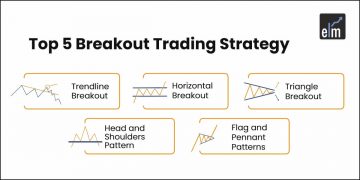Moving average is a popular technical analysis trend following indicators. It is basically a mathematical device which is used to detect the underlying trend of the share. It is also known as laggard indicator.
Moving average for trading follows the trend and accordingly generates a buy and sell signal.
There are mainly 3 types of indicators in technical analysis-
1. Trend following indicator or laggard indicator
2. Oscillators or advanced indicator
3. Co-incidental indicators
However, the signal we get from moving average is often a bit late. Although it produces a late signal but it is a confirm signal. Using moving average for trading is like attending a party where the cocktail is over but dinner is left. Hence moving average is called laggard indicator.
| Table of Contents |
|---|
| Types of Moving Average |
| Types of Trends on the basis of Time |
| Bottomline |
Types of Moving Average
1. Exponential moving average
2. Simple moving average
3. Weighted moving average
Out of this, the simple moving average is easy to calculate. Moving average is calculated with the help of closing price. If we want to find out the ten-day moving average of a particular share, we will consider last 10 closing prices, add them and then divide it by 10, whatever the result produced will be known as 10 DMA.
Read more: Why Moving Average is important for your technical toolbox
With the passage of time, as more and more research came into the subject, the system of double moving average was brought in. In this system, we will have two different periods and thereby two individual moving average. Whenever we choose any time frame either 7,20 or 5,10 or 9, 15, we normally have two periods out of which one is smaller period and the other is a longer period. The smaller period is called short-term moving average (STMA) or present MA and the long term is called LTMA or past MA.
The relative relationship between these two lines of moving average gives us a proper signal with regards to the direction of the trend. The most commonly used combination is 13 and 30. We must note that this 13 and 30 is used on a weekly chart top to understand the proper direction of the price. Weekly chart means we have to consider the last working day closing of the week for 13 and 30 as well. The system of DMA works as follows-
a. During an uptrend, the 13 weeks moving average (STMA) will be greater than 30 weeks (LTMA) and both constantly rise as long as these 2 averages behave in the manner, we have to say that trend is definitely up.
b. During a downtrend, the 13 weeks MA (STMA) will be lesser than LTMA of 30 weeks and both will continue to fall. As long as this behavior is on, the trend is perfectly down.
Learn in 2 hours – Magic of Moving Averages
We must note that we are either interested in both the line rising or both the line falling. Apart from these, any other line behavior, we are not interested. For example, sometimes it happens that short-term moving average for trading is rising whereas the long-term moving average for trading is falling. This is not a perfect signal of any trend because both the line are in opposite direction. Hence apart from straight rising or straight falling, any other line of behavior is not to be taken into consideration.
Types of Trends on the basis of Time
1. Short term trends
The duration of the trend lasts for o days to 3 weeks. We can use 20 DMA or a combination of 4, 9 and 18 DMA.
2. Intermediate trend
This trend lasts for a period of 3 weeks to 3 months. Some people call it a secondary trend. We can use the combination of 13, 30 weeks SMA.
3. Long-term trend
Any trend that lasts for a period of 6 months or above, this is called the long-term trend., To understand the direction of the long-term trend, we can use 50 and 200 MA (days).
Bottomline
In order to understand the short-term trade, we have to use 3 moving averages i.e. 4 DMA, 9 DMA, and 18 DMA. During an uptrend for short term, 4 DMA will be greater than 9 DMA and 9 DMA will be greater than 18 DMA. For a short-term downtrend, 4 DMA will be less than 9 DMA and 9 DMA will be less than 18 DMA. Needless to say, during an uptrend, all the 3 will rise and during a downtrend, all the 3 will fall. The same logic can be applied for intermediate and long-term trend.
In order to get the latest updates about Financial Markets visit Stockedge.








Thanks for the clarity of your explanations. If find time please continue with this kind of information for other indicators.
I just like the helpful information you supply for your articles. I’ll bookmark your blog and check again right here regularly. I’m relatively sure I’ll learn lots of new stuff right here! Best of luck for the next!